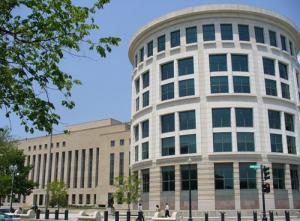Federal Courts Review Two Separate Projects

In a sign that the Dakota Access and Keystone XL pipelines are not the only controversial ones in the country, two different federal appellate courts have issued rulings in the last week that may have implications for a number of other pipeline facilities.
In the first decision, released August 18, the U.S. Court of Appeals for the Second Circuit held that the state of New York was within its rights to deny a pipeline developer a water quality permit for the planned construction of the Constitution Pipeline.
In the other decision, from the week of August 25, the U.S. Court of Appeals for the District of Columbia Circuit told the Federal Energy Regulatory Commission (FERC) that the agency had erred in not considering the potential effects of greenhouse gas emissions within the context of its environmental impact assessment relative to the Sabal Trail Pipeline in Florida. However, the D.C. Circuit's order may be of less consequence to the Sabal Trail project than is the Second Circuit's to the Constitution Pipeline. That is because the Sabal Trail facility is already completed and was placed in service two months ago, while no work on the New York project has yet begun.
The proposed Constitution Pipeline would follow a 121-mile route from Pennsylvania into New York, with the vast majority of the line being located in New York. It is designed to bring "fracked" gas from the Marcellus Shale Formation in Pennsylvania to a terminus not too far from Schenectady. For much of the 98 miles that lie in New York, the line would run roughly parallel to both Interstate 88 and the Susquehanna River. According to information provided by various environmental protection groups, the pipeline would cross hundreds of smaller streams, creeks, and wetland areas. The project would require the clearing of at least 500 acres of forestland as well, they testified.
The proximity of the pipeline to so many natural resources accounted in part for a decision by the New York Department of Environmental Conservation (DEC) to reject the developer's application for water quality certification under Section 401 of the federally promulgated Clean Water Act. According to the DEC, the pipeline company had failed to show that the project would be able to comply with New York's own water quality standards, which in some cases exceed those listed in the Clean Water Act.
The project sponsor thereupon filed suit against the DEC, claiming that because it had previously obtained a certificate of public convenience and necessity from FERC, New York had, in essence, been preempted from preventing the pipeline from going forward. To that end, the pipeline equated DEC's denial of the water quality permit to an impermissible veto of the FERC's prior decision to grant a certificate.
The project developer also contended that, in deference to DEC's wishes and FERC requests, it had sited the pipeline so as to maximize its ability to use a "trenchless" construction model that would minimize water crossings in the state. The pipeline also pointed to numerous statements from energy officials in both New York and New England about the need to relieve natural gas transmission congestion, which it asserted the Constitution Pipeline would do.
The appeals court, however, found that the DEC, joined by various advocacy groups, had mounted an effective defense. The court ruled that there was simply no basis for the pipeline company's arguments that the DEC's denial of the water quality permit had been beyond its authority or arbitrary or capricious. The court held further that it was reasonable for New York to engage in a heightened review of the pipeline's application in an effort to protect its jurisdictional waterways. In that regard, the court observed that the Clean Water Act explicitly reserves to the states authority to determine issues associated with a planned facility's impact on in-state water quality.
By extension, the appellate court said, it was appropriate for a state to examine alternative routes or siting proposals so as to mitigate any potential harm to bodies of water within its boundaries. Moreover, the court cited the fact that New York had received approval from the U.S. Environmental Protection Agency for the state's own water quality standards.
The court concluded that it had clearly been contemplated by Congress in crafting the Clean Water Act that states might enact more stringent water quality criteria on their own. Indeed, it stated, other court precedent had established that "Congress intended that the states would retain the power to block, for environmental reasons, local water projects that might otherwise win federal approval."
The court added that it is "plainly within the state's authority" to weigh possible alternatives that would produce a significantly less impactful effect on state waterbodies. It thus deemed the DEC to have acted in a wholly lawful and appropriate manner in rejecting the pipeline's request for water quality certification. Constitution Pipeline Co., LLC v. New York State Department of Environmental Conservation et al., Docket No. 16-1568, Aug. 18, 2017 (2nd Cir.).
In the other court proceeding, involving the Sabal Trail Pipeline, the D.C. Circuit remanded the matter to the FERC, with instructions that it prepare an updated and expanded environmental impact statement (EIS) on the project. Despite the directive that FERC reconsider the Sabal Trail EIS, it actually is doubtful that the D.C. Circuit's order will impede operations at the facility on a long-term basis, since it is already in service. The Sabal Trail line originates in Tallapoosa County, Alabama, and ends approximately 500 miles away in Osceola County, Florida, just south of Orlando. The pipeline was proposed in response to growing demand for electricity in Florida and a desire to see more generation fueled by natural gas.
Florida Power & Light Company, one of the utilities that has committed to purchasing much of the natural gas transmitted through the pipeline, had supported the project by explaining that it was rapidly reaching the point where its gas supply needs would outstrip current pipeline capacity. The utility also averred that increased reliance on natural gas as a fuel source for electricity generation would allow it to accelerate its retirement of older, dirtier coal-fired power plants, for the betterment of Florida's air quality.
Such claimed attributes notwithstanding, the Sabal Trail facility had been opposed by many nearby property owners as well as a number of environmental advocacy groups. But despite such protests, the FERC granted the developer a certificate of public convenience and necessity in early 2016. That award was quickly challenged in court by various entities, led by the Sierra Club.
The plaintiffs' primary argument was that the FERC had utilized an invalid methodology in devising the EIS for the project. More particularly, they attested that the EIS should have incorporated a factor specific to the greenhouse gases (GHGs) that ultimately would be emitted by the generating units fired by the natural gas transported via the pipeline. The complainants likewise faulted the EIS for not fully considering the impact of pipeline construction in low-income and minority communities, given that disproportionately large segments of the pipeline would be sited in such economically disadvantaged neighborhoods.
In accepting the positions staked out by the Sierra Club and others, the appeals court agreed that the FERC had not adequately studied the GHG aspect of pipeline operations. It similarly concurred that the FERC had failed to grasp the extent to which lower-income citizens might be affected by the project.
The court elaborated that its review of the EIS showed that it did not include sufficient information on the GHG emissions "that will result from burning the gas that the pipelines will carry." And, the court said, that omission was compounded by the fact that the FERC also had failed to take into account how such GHGs would impact so-called "environmental justice communities."
The court stated that such areas are characterized by a majority of their residents being low-income and/or minorities. It related that because they are often already surrounded by commercial and industrial complexes, they have been "overburdened by pollution" as it is. Thus, the court opined, location of the new pipeline in such regions would expose them to even greater amounts of hazardous emissions. The court remarked that the EIS acknowledges that almost 84% of the Sabal Trail Pipeline would be routed through areas identified as environmental justice communities.
The court emphasized that the FERC had not totally disregarded the GHG and low-income issues pertaining to the Sabal Trail Pipeline. Rather, the court said, the agency had not accorded such matters the weight that they deserved. The court stated that such factors required more than just cursory consideration.
In the Sabal Trail case, the court said that the adage that "it's not just the destination, it's the journey" should be turned around. From the court's perspective, that saying should be "It's not just the journey, though, it's also the destination" with respect to the Sabal Trail Pipeline. The court expounded that since the gas traveling through the pipeline will end up at power plants in Florida, which plants will produce GHGs in addition to electricity, the FERC should have discussed those "downstream" effects when composing the EIS.
As noted previously, however, given that the pipeline is already in operation, it remains to be seen what actual effect, if any, the EIS remand will have. It is perhaps somewhat ironic, though, that the state has recently received a number of complaints from people living in close proximity to the pipeline about a foul smell emanating from the line.
While inspectors traced the odors to certain equipment connected to a compressor station, as opposed to a leak in the pipeline itself, opponents of the project have pointed to the odors as evidence of the adverse environmental impacts the pipeline could have, thus underscoring the propriety of a more vigorous EIS process by the FERC. Sierra Club et al. v. Federal Energy Regulatory Commission, No. 16-1329, Aug. 22, 2017 (D.C. Cir.).



